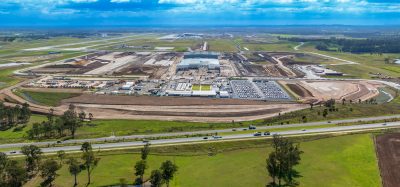Airport pavement rehabilitation by rubblisation
- Like
- Digg
- Del
- Tumblr
- VKontakte
- Buffer
- Love This
- Odnoklassniki
- Meneame
- Blogger
- Amazon
- Yahoo Mail
- Gmail
- AOL
- Newsvine
- HackerNews
- Evernote
- MySpace
- Mail.ru
- Viadeo
- Line
- Comments
- Yummly
- SMS
- Viber
- Telegram
- Subscribe
- Skype
- Facebook Messenger
- Kakao
- LiveJournal
- Yammer
- Edgar
- Fintel
- Mix
- Instapaper
- Copy Link
Posted: 30 September 2008 | Dr. Navneet Garg, Project Manager, Airport Technology R&D Branch, William J. Hughes Technical Center, Federal Aviation Administration | No comments yet
Concrete pavements exhibiting distresses such as cracking, joint deterioration, spalling, and joint faulting can be rehabilitated by constructing a concrete or asphalt overlay. The ‘crack and seat’ technique is the most prevalent method for deteriorated concrete pavement rehabilitation. However, ‘rubblisation’ is fast becoming a popular method of concrete pavement rehabilitation.
Concrete pavements exhibiting distresses such as cracking, joint deterioration, spalling, and joint faulting can be rehabilitated by constructing a concrete or asphalt overlay. The ‘crack and seat’ technique is the most prevalent method for deteriorated concrete pavement rehabilitation. However, ‘rubblisation’ is fast becoming a popular method of concrete pavement rehabilitation.
Asphalt overlays placed over existing Portland cement concrete pavements reflect the joints and cracks present in the underlying concrete pavement. Once reflected into the asphalt overlay, these cracks represent a major maintenance concern and are a known source of foreign object damage. According to the National Asphalt Pavement Association, rubblisation is the most effective procedure for addressing reflective cracking in asphalt overlays.
Rubblisation could be a cost-effective means of converting an existing failed or failing concrete pavement into a superior base, thereby eliminating the expense of removal and replacement.
What is rubblisation?
Rubblisation is the process of breaking the existing concrete pavement in-situ into small interconnected pieces that serve as a base course for a new asphalt overlay. The rubblised concrete layer behaves as a tightly keyed, interlocked, high-density unbound base. The rubblisation process destroys the slab action by breaking the concrete slab into one to three inch pieces at the top and three to 15 inch pieces at the bottom. Some of the reasons for the growing popularity of rubblisation are ease of construction, little or no patching requirements, reduced construction costs, more uniform pavement and reduced pavement maintenance costs1.
Rubblisation is generally performed by two available pieces of equipment: The Multi-Head Breaker (MHB) or the Resonant Pavement Breaker (RPB) Figure 1 and 2 on page 21 show the MHB and RPB respectively.
FAA and rubblisation
The Federal Aviation Administration (FAA) does not currently have a thickness design standard for asphalt overlays over rubblised concrete pavements. However, Engineering Brief (EB) 662 summarises the guidelines for rubblised Portland cement concrete base courses. These guidelines are based on industry experience and provide interim guidance. Full-scale testing is still needed to develop design standards for the use of this technology at airports.
Full-scale testing of rubblised pavements with asphalt overlay at NAPTF
Three concrete airport pavement test items were rubblised at the FAA’s National Airport Pavement Test Facility (NAPTF – Figure 3). These three pavements had 12-inch thick concrete slabs on different support systems, slab on crushed stone base (MRC), slab on grade (MRG) and slab on stabilised base (MRS). After rubblisation, they were overlaid with five inches of asphalt. The overlaid pavements were subjected to full-scale accelerated traffic loading under heavy aircraft gear loads.
Each test item consisted of two 30-foot wide traffic lanes, designated north and south lanes. Construction was completed in April 2004 and traffic testing was completed by December 2004. In January 2005, all of the concrete slabs in the north traffic lane were rubblised with an RMI RB-500 resonant breaker. Figure 4 shows the test pavement surface after rubblisation.
After rubblisation, a four-square foot test pit was saw cut in each test item for visual examination of the rubblised concrete, to determine the extent of fractures from the rubblisation process, particle sizes, etc. Figure 5 shows fracture patterns and particle sizes in test items. In general, the top two to three inches in all the test items were rubblised into dust and stones, with a maximum particle size of one inch. The particle size in the bottom nine inches ranged from four inches to 15 inches, with larger particle sizes in MRS. The test pits showed that the rubblisation process induced cracks/fractures for the entire depth of the slabs and the cracks were tightly held.
In June 2005, the rubblised pavement was wetted, rolled with a vibratory steel drum roller and overlaid with five inches of P-401 hot mix asphalt. The non-rubblised south side also received the asphalt overlay.
Pavement testing started on 7 July 2005 and continued until 6 October 2005. The traffic was applied in a predetermined wander pattern. The temperature of the asphalt varied between 66 and 85ºF during the period of testing. Traffic testing was continued until either structural failure occurred or it was estimated that failure was unlikely to occur within a reasonable number of passes at the applied load. In the latter case, the loading was increased.
During the traffic tests, the test items were monitored through a combination of visual surveys and non-destructive testing, including periodic straightedge rut depth measurements, surface profile measurements and deflection measurements. Due to a minimal amount of distress, applied wheel loads were increased from 55,000 lbs (four-wheel dual-tandem landing gear configuration) to 65,000 lbs (six-wheel triple-tandem landing gear configuration). The landing gear configuration had dual and tandem spacing of 54 and 57 inches respectively.
Of the three rubblised test items, MRC suffered severe structural distress (severe surface rutting and upheaval as shown in Figure 6). Test item MRG had suffered severe structural deterioration at the end of trafficking, but retained sufficient structural capacity to support the applied load (Figure 7). The third rubblised pavement (MRS) did not suffer severe structural deterioration at the end of trafficking (Figure 8).
After completion of the traffic tests, trenches were dug perpendicular to the centre-line of test items to conduct post-traffic investigation into the failure mechanism of the pavement structures. Tests and measurements were performed on the various layers of the pavement structure. The results from the post-traffic tests were useful in providing some insight into the failure mechanism of rubblised concrete pavements. In addition, the results indicated that for the conditions existing in the test pavements, the assumptions for design in EB66 are overly conservative. None of the non-rubblised pavements suffered significant structural deterioration or significant levels of rutting. There was also no evidence of reflection cracking at the surface of the non-rubblised pavements, but this is to be expected, because the tests were performed indoors during warm weather.3 More detailed information about FAA’s full-scale testing of rubblised concrete pavements with asphalt overlay including pavement performance and post-traffic test results can be found in references three and four4.
For commercial airports serving wide body aircraft with gross weights over 100,000 lbs, as per the FAA AC 150/5320-6E, rigid pavements are required to have a stabilised base. MRS is the most representative of pavement structures that are encountered on a commercial airport in the United States. The performance of MRS under a 65,000 lb wheel load suggests that rubblised concrete pavements with an asphalt overlay are a viable option for pavement rehabilitation on commercial airports. The presence of a stabilised base underneath the rubblised concrete layer limits the vertical deflection in the layer below the rubblised concrete layer and helps to keep the rubblised pieces tightly interlocked. Thickness design procedure for asphalt overlays over rubblised concrete pavement is available in FAA airport pavement thickness design procedure FAARFIELD.
The recommended modulus values for the rubblised concrete layer range from 100 ksi to 400 ksi. Some engineering judgment is required for the selection of an appropriate modulus value. The following ranges are suggested for selecting a design modulus value for rubblised concrete on airfields:
- For slabs six to eight inches thick: Moduli from 100 to 135 ksi
- For slabs eight to 14 inches thick: Moduli from 135 to 235 ksi
- For slabs >14 inches thick: Moduli from 235 to 400 ksi
In selecting a value, consideration must be given to such factors as the level of conservatism in the design, exact slab thickness, pre-rubblised concrete modulus, anticipated particle size, steel de-bonding conditions and relevant historical data. For further insight into selecting a design modulus for rubblised concrete, see reference AAPTP 04-015. A structural evaluation of the existing pavement, traffic, sub-grade and environmental conditions must be performed prior to rubblisation to determine if the technique is well suited to the characteristics of the specific pavement.
It is important to understand the soil and moisture conditions for the pavement system prior to making a decision on the type of pavement rehabilitation to use.
Acknowledgements
The author would like to thank Dr. Satish Agrawal (Manager, Airport Technology R&D Branch), Jeffrey Gagnon (Manager, Airport Pavements AJP-6312), Dr. Gordon Hayhoe (Manager, NAPTF), Paul Jones (Manager, Airport Safety) and Hector Daiutolo (SRA) for their contribution to this article.
References
- Buncher, M., and Jones, H. W., Rubblisation of Airfield Pavements – State of the Practice, Rubblisation of Portland Cement Concrete Pavements, Transportation Research Circular E-C087, Transportation Research Board, January 2006.
- Rubblised Portland Cement Concrete Base Course, Engineering Brief No. 66, Airport Engineering Division, Federal Aviation Administration, Washington, D.C., 2004.
- Hayhoe, G. F., and Garg, N., Characterization of Rubblised Concrete Pavements with HMA Overlays at the National Airport Pavement Test Facility, Proceedings of the 2006 T&DI Airfield and Highway Pavement Specialty Conference – Meeting Today’s Challenges with Emerging Technologies, Atlanta, Georgia, May1-3, 2006.
- Garg, N. and Hayhoe, G., Characterization of Rubblised Concrete Airport Pavements at the NAPTF Using Non-Destructive Testing Methods, FAA Worldwide Airport Technology Transfer Conference, Atlantic City, NJ, Apr 2007.
- Buncher, M., Fitts, G., Scullion, T., and McQueen, R. D., Development of Guidelines for Rubblisation, Final Report, Airfield Asphalt Pavement Technology Program Project 04-01, Asphalt Institute, Lexington, KY, May 23, 2008.

















